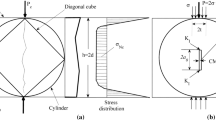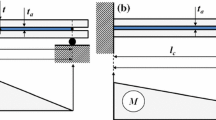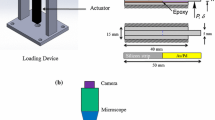Abstract
Thin layer splitting along the elastic-plastic solid surface is studied based on the elastic-plastic fracture mechanics method. In the splitting process, since the split arm does not undergo the reversed plastic bending, comparing with the conventional peel test method, the split test has remarkable advantages in measuring the material fracture behavior and is recommended as a new test method. Moreover, besides the driving force parameter, the split test method provides an additional measurable parameter, a residual curvature (or curvature radius) of the split arm. Comparing with the peeling force, the split force also has the connection with the total energy release rate, which is related with the crack tip separation energy (or material fracture toughness), separation strength, and the plastic dissipation work. Through measuring the driving force and the residual curvature, the fracture toughness and separation strength can be obtained. The primary objective of the present research is to develop a series of relations of the split force, the residual curvature, as well as the crack tip slope angle, respectively with the split layer thickness and material parameters, when crack tip advances steadily. Frictionless (or smooth) contact between splitter head and split arm surface is assumed. Another objective of the present research is to explore a connection between the split test solutions and the peel test solutions. Finally, the split test analysis is applied to a wedge-loaded double-cantilever beam experiment for Al-alloy material, a considerably similar test method with the split test, conducted by Thouless and his collaborators, and the fracture parameters from both test systems are correlated.
Similar content being viewed by others
References
Acharya, A. and Bassani, J.L. (1995). On non-local flow theories that preserve the classical structure of incremental boundary value problems. Micromechanics of Plasticity and Damage in Multiphase Materials, IUTAM Symposium, Paris.
Aifantis, E.C. (1992). On the role of gradients in the localization of deformation and fracture. Int. J. Engng. Sci. 30 1279–1299.
Dean, R.H. and Hutchinson, J.W. (1980). Quasi-static steady crack growth in small scale yielding. Fracture Mechanics, ASTM STP 700, American Society for Testing Materials, pp. 383–405.
Evans, A.G., Hutchinson, J.W. and Wei, Y. (1999). Interface adhesion: effects of plasticity and segregation. Acta Mater. 47 4093–4113.
Fleck, N.A. and Hutchinson, J.W. (1997). Strain gradient plasticity. Adv. Appl. Mech. 33 295–361.
Gao, H., Huang, Y., Nix, W.D. and Hutchinson, J.W. (1999). Mechanism-based strain gradient plasticity–I. Theory. J. Mech. Phys. Solids 47 1239–1263.
Kim, J., Kim, K.S. and Kim, Y.H. (1989). Mechanical effects of peel adhesion test. J. Adhe. Sci. Tech. 3 175–187.
Kim, K.S. and Aravas, N. (1988). Elasto-plastic analysis of the peel test. Int. J. Solids Struct. 24 417–435.
Kim, K.S. and Kim, J. (1988). Elasto-plastic analysis of the peel test for thin film adhesion. J. Engin. Mat. Tech. 110 266–273.
Kinloch, A.J., Lau, C.C. and Williams, J.G. (1994). The peeling of flexible laminates. International Journal of Fracture 66 45–70.
Moidu, A.K., Sinclair, A.N. and Spelt, J.K. (1995) Analysis of the peel test: prediction of adherend plastic dissipation and extraction of fracture energy in metal-to-metal adhesive joints. J. Testing Evaluation 23 241–253.
Needleman, A. (1987). A continuum model for void nucleation by inclusion debonding. J. Appl. Mech. 54 525–531.
Suo, Z. Shih, C. F. and Varias, A. G. (1993). A theory for cleavage cracking in the presence of plastic flow. Acta Metall. Mater. 41 151–157.
Thouless, M.D., Adams, J.L., Kafkalidis, M.S. et al. (1998). Determining the toughness of plastically deforming joints. J. Mater. Sci. 33 189–197.
Thouless, M.D., Kafkalidis, M.S., Ward, S.M. et al. (1997). Toughness of plastically-deforming asymmetric joints. Scripta Mater. 37 1081–1087.
Tvergaard, V. and Hutchinson, J.W. (1992). The relation between crack growth resistance and fracture process parameters in elastic-plastic solids. J. Mech. Phys. Solids 40 1377–1397.
Tvergaard, V. and Hutchinson, J.W. (1993). The influence of plasticity on mixed mode interface toughness. J. Mech. Phys. Solids 41 1119–1135.
Wei, Y. and Hutchinson, J.W. (1997a). Nonlinear delamination mechanics for thin films. J. Mech. Phys. Solids 45 1137–1159.
Wei, Y. and Hutchinson, J.W. (1997b). Steady-state crack growth and work of fracture for solids characterized by strain gradient plasticity. J. Mech. Phys. Solids 45 1253–1273.
Wei, Y. and Hutchinson, J.W. (1998). Interface strength, work of adhesion and plasticity in the peel test. International Journal of Fracture 93 315–333.
Wei, Y. and Hutchinson, J.W. (1999). Models of interface separation accompanied by plastic dissipation at multiple scales. International Journal of Fracture 95 1–17.
Yang, Q.D., Thouless, M.D. and Word, S.M. (1999). Numerical simulations of adhesively-bonded beams failing with extensive plastic deformation. J. Mech. Phys. Solids 47 1337–1353.
Author information
Authors and Affiliations
Rights and permissions
About this article
Cite this article
Wei, Y. Thin layer splitting along the elastic-plastic solid surface. International Journal of Fracture 113, 233–252 (2002). https://doi.org/10.1023/A:1014230227262
Issue Date:
DOI: https://doi.org/10.1023/A:1014230227262




